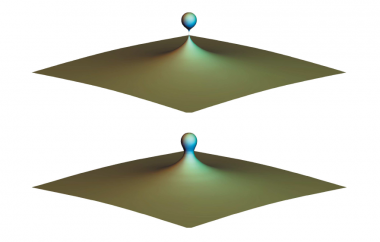SINC: How to Merge Two Black Holes in a Simple Way
Posted: Mon Sep 26, 2016 7:39 pm
How to Merge Two Black Holes in a Simple Way
Information and Scientific News Service (SINC) | 2016 Sep 26
Exact Event Horizon of a Black Hole Merger - Roberto Emparan, Marina Martinez
Information and Scientific News Service (SINC) | 2016 Sep 26
[c]The merger of two black holes, such as the one which produced the gravitational waves discovered by the LIGO Observatory, is considered an extremely complex process that can only be simulated by the world’s most powerful supercomputers. However, two theoretical physicists from the University of Barcelona have demonstrated that what occurs on the space-time boundary of the two merging objects can be explained using simple equations, at least when a giant black hole collides with a tiny black hole.
The merger of two black holes, where one is so large that only a portion of it –nearly flat–
is shown, while the other, smaller black hole falls into and is absorbed by the larger one.
Image: Roberto Emparan & Marina Martínez[/c][hr][/hr]
If we had to choose the most important and newsworthy piece of science news for 2016, the discovery of gravitational waves would have every chance of winning first prize.
The two signals that have been produced so far came from the collision and merger of two black holes in some remote part of the universe. The first detection was announced in February and the second in June, both by scientists from the Laser Interferometer Gravitational-Wave Observatory (LIGO) in the United States.
To determine the patterns of these waves and simulate how those mysterious fusions take place –a phenomenon characteristic of Einstein’s general theory of relativity– scientists use the best supercomputers, such as the MareNostrum from Barcelona, Spain’s most powerful supercomputer; however, there could be other, less complicated ways.
Physicists Roberto Emparan and Marina Martínez from the University of Barcelona have found a simple and exact way to approach the subject of the event horizon of two merging black holes, where one is much smaller than the other. ...
Exact Event Horizon of a Black Hole Merger - Roberto Emparan, Marina Martinez
- Classical and Quantum Gravity 33(15):5003 (04 Aug 2016) DOI: 10.1088/0264-9381/33/15/155003
arXiv.org > gr-qc > arXiv:1603.00712 > 02 Mar 2016 (v1), 27 Jun 2016 (v3)
